Related Research Articles

"Lupang Hinirang", originally titled in Spanish as "Marcha Nacional Filipina", and commonly and informally known by its incipit "Bayang Magiliw", is the national anthem of the Philippines. Its music was composed in 1898 by Julián Felipe, and the lyrics were adopted from the Spanish poem "Filipinas", written by José Palma in 1899.

The Katipunan, officially the Kataastaasang, Kagalanggalangang Katipunan ng mga Anak ng Bayan or Kataastaasan Kagalang-galang na Katipunan ng mga Anak ng Bayan, was a Philippine revolutionary society founded by anti-Spanish colonialist Filipinos in Manila in 1892; its primary goal was to gain independence from Spain through a revolution.
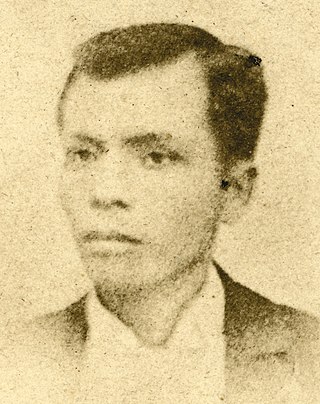
Andrés Bonifacio y de Castro was a Filipino revolutionary leader. He is often called "The Father of the Philippine Revolution", and considered one of the national heroes of the Philippines.

Filipino is a language under the Austronesian language family. It is the national language of the Philippines, and one of the two official languages of the country, with English. It is a standardized variety of Tagalog based on the native dialect, spoken and written, in Metro Manila, the National Capital Region, and in other urban centers of the archipelago. The 1987 Constitution mandates that Filipino be further enriched and developed by the other languages of the Philippines.
Filipinoorthography specifies the correct use of the writing system of the Filipino language, the national and co-official language of the Philippines.
The Coalition Against the Marcos Dictatorship was a North America-based antiimperialist organization that was at the center of the international movement opposing the dictatorship of Philippine President Ferdinand Marcos from the 1970s.
Tagalog Republic is a term used to refer to two revolutionary governments involved in the Philippine Revolution against the Spanish Empire and the Philippine–American War. Both were connected to the Katipunan revolutionary movement.

Mariano M. Álvarez was a Filipino revolutionary and statesman.
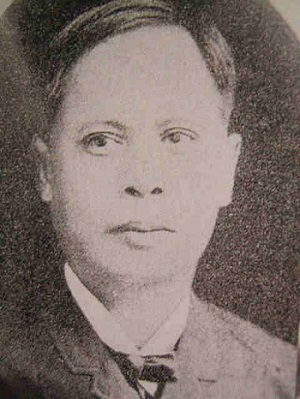
Deodato Arellano y de la Cruz was a Filipino propagandist and the first president of the Katipunan, which was founded at his home in Azcarraga Street, Manila. He was first to be given the title Supremo by the Katipunan. After studying bookkeeping in Ateneo de Municipal de Manila, he became an assistant clerk for the Spanish military. He was a member of the Freemasonry in the Philippines and became involved in the Propaganda Movement.

The Tejeros Convention, also known as the Tejeros Assembly and the Tejeros Congress, was a meeting held on March 22, 1897, between Katipunan factions of Magdiwang and Magdalo in San Francisco de Malabon, Cavite that resulted in the creation of a new revolutionary government that took charge of the Philippine Revolution, replacing the Katipunan. It followed on a previous meeting now known as the Imus Assembly. Filipino historians consider the first presidential and vice presidential elections in Philippine history to have been held at this convention, although only Katipuneros were able to take part, and not the general populace.
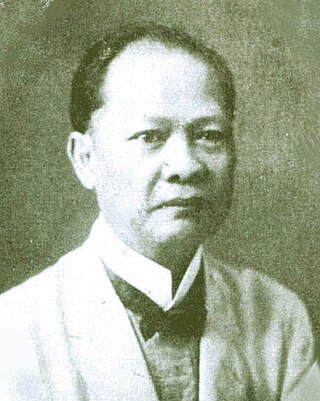
Julio Nakpil y García was a Filipino musician, composer and a General during the Philippine Revolution against Spain. He was a member of the Katipunan, a secret society turned revolutionary government which was formed to overthrow the Spanish government in the Philippines. His Katipunan adoptive name was J. Giliw or simply Giliw. He was commissioned by Andres Bonifacio, President of the Insurgent Tagalog Republic, to compose a hymn which was intended to become the National Anthem of the Tagalog Republic. That hymn was entitled "Marangal na Dalit ng Katagalugan". Thus, to some, he is remembered as the composer of the first national anthem of the Philippines. He is also a known huge critic of Emilio Aguinaldo.
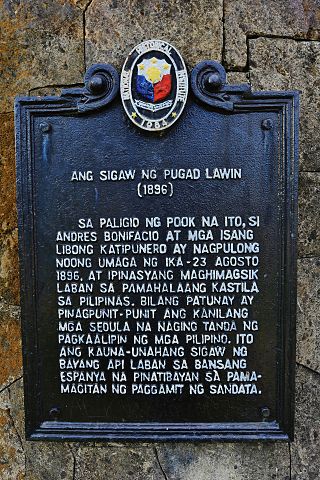
The Cry of Pugad Lawin was the beginning of the Philippine Revolution against the Spanish Empire.

Emilio Jacinto y Dizon was a Filipino general during the Philippine Revolution. He was one of the highest-ranking officers in the Philippine Revolution and was one of the highest-ranking officers of the revolutionary society Kataas-taasang, Kagalang-galang na Katipunan ng mga Anak ng Bayan, or simply and more popularly called Katipunan, being a member of its Supreme Council. He was elected Secretary of State for the Haring Bayang Katagalugan, a revolutionary government established during the outbreak of hostilities. He is popularly known in Philippine history textbooks as the Brains of the Katipunan while some contend he should be rightfully recognized as the "Brains of the Revolution". Jacinto was present in the so-called Cry of Pugad Lawin with Andrés Bonifacio, the Supremo of the Katipunan, and others of its members which signaled the start of the Revolution against the Spanish colonial government in the islands.
The New Design Series (NDS) (also known as the BSP Series after the establishment of the Bangko Sentral ng Pilipinas) was the name used to refer to banknotes of the Philippine peso issued from 1985 to 2013 and the coins of the Philippine peso issued from 1995 to 2017. The banknotes were printed until 2013 (with 5-peso note were printed until 1995, 10-peso note until 2001, 20 and 1000 peso notes until 2012, and 50, 100, 200 and 500 peso notes until 2013), legal tender until December 31, 2015, and can be exchanged with NGC notes until its demonetization on December 29, 2017, where they co-existed with the NGC banknotes from December 16, 2010 to December 29, 2017. The coins were minted and issued from c. December 1995 to November 30, 2017, and remain legal tender as of 2023. It was succeeded by the New Generation Currency (NGC) Series issued on December 16, 2010, for banknotes and November 30, 2017, for coins.
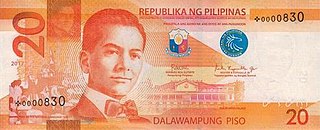
The Philippine twenty-peso note (₱20) is a denomination of Philippine currency. It is the smallest banknote denomination in general circulation in the Philippines. Philippine president Manuel L. Quezon is currently featured on the front side of the note, while the Banaue Rice Terraces and the Asian palm civet is featured on the reverse side.

The Philippine ten-peso note (₱10) was a denomination of Philippine currency. In its latest incarnation, Apolinario Mabini and Andrés Bonifacio are featured on the front side of the notes, while the Barasoain Church and a Blood Compact scene of the Katipuneros are featured on the reverse side. This banknote was circulated until the demonetization of the New Design Series on December 29, 2017. Its printing was stopped in 2001 and was replaced by coins.

The Evolution of the Philippine Flag is a set of flags consisting of select banners of the Katipunan of the Philippine Revolution. Often displayed with the flag of the First Republic, it is sometimes erroneously interpreted to imply the chronology of the national flag of the Philippines.

The Bantayog ng mga Bayani, sometimes simply referred to as the Bantayog, is a monument, museum, and historical research center in Quezon City, Philippines, which honors the martyrs and heroes of the struggle against the dictatorship of former President Ferdinand Marcos.
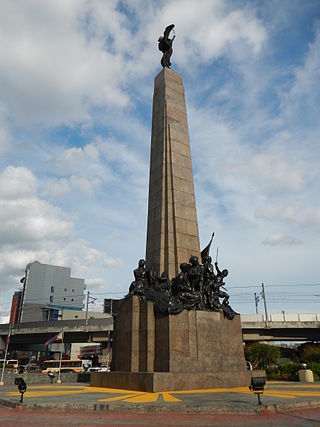
The Andrés Bonifacio Monument, commonly known simply as Bonifacio Monument or Monumento, is a memorial monument in Caloocan, Philippines which was designed by National Artist Guillermo Tolentino to commemorate the Philippine revolutionary Andrés Bonifacio, the founder and Supremo of the Katipunan, who fought for independence from the politically and socially ruthless colonial rule by Spain.

The Bonifacio Shrine, also known as the Kartilya ng Katipunan or Heroes Park, is a public park and plaza in Ermita, Manila, Philippines located just north of the Manila City Hall and south of Mehan Garden and Liwasang Bonifacio. Its centerpiece is the monument to Filipino revolutionary Andrés Bonifacio and the Philippine Revolution fronting Padre Burgos Avenue.
References
- ↑ Cultural Center of the Philippines (1994). CCP Encyclopedia of Philippine Art: Philippine literature. Cultural Center of the Philippines. ISBN 978-971-8546-43-7.
- ↑ “Z.Ll.B” was the Katipunan code for “A.N.B.” – “Anak ng Bayan” or “Sons of the People”.
- ↑ Adrian E. Cristobal, The Tragedy of the Revolution (Makati City: Studio 5 Publishing Inc., 1997), 40.